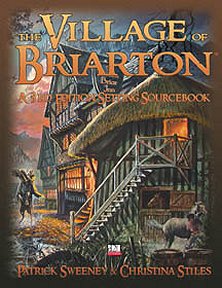
The basic concept of this book is to provide a generic but beautifully detailed village (or small town), which the DM can place in his campaign world - possibly as a base or as somewhere the characters will pass through. To this end, the history, economics, inhabitants and surrounding areas are all described, so that the entire village may be picked up and used with little need for preparation save deciding just where it is, and how it fits in to everything else that is going on.
Indeed, the introduction looks at various ways in which the village might feature. Perhaps it is the home of one or more young adventurer, starting out on his career. The group, as newcomers to the 'hero' business, might even have their first adventures here before moving on to bigger things. A village environ should provide an easy start, with challenges at the right level - how many big cities really have well-signposted novice-level dungeons to explore? Once characters have gained some experience, they might be ready to move on. Or, of course, this could be somewhere they find later... somewhere that on the surface looks like a good place for a rest, but where there is really plenty going on! Or it might be the nearest settlement to the traditional 'somewhere out in the wilds' dungeon complex, the logical place for the characters to rest and resupply.
Everything is a wonderful combination of great detail and total portability. Although there's a lord of the area, and some recent history as to how he was appointed, there's plenty of space to change it around to suit the history of the region (or to change the fellow in charge). Two deities are provided - and with considerable detail if you'd like to use them - but can be easily replaced by a 'good' and an 'evil' deity from your own pantheon. While about 50 inhabitants are given names, trades and other details; there are about 400 more whom are there for you to use as you see fit. Some of them might be your PCs, if you decide that this is where they come from!
Individual characters are given complete write-ups, including statistic blocks and sufficient characterisation and background to make them come alive; while little 'interaction seed' suggestions of ways of using them in anything from a brief interlude to a full-blown adventure are scattered throughout. Many adventurers regard any settlement as a place to stock up on supplies, so the number of shops and other businesses that are detailed and populated is very useful. The other major reason to visit a town - to visit an inn! - is also catered for, with a detailed establishment called the Greenbriar Inn. A nice touch is the pricelist, preventing that deathly silence when a character asks how much he will have to pay for the ale, food and accommodation he has ordered - there are even enough options available to allow for an impressive response if asked what's on the menu.
The 'good' deity, Erilys, is a particularly nice and 'homely' goddess; one well worth considering adding to your campaign's pantheon if there is no suitable figure already there. As well as Good, Healing and Protection, she controls a new domain called Hearth, which enables its practitioners to provide support and protection to a community.
Not all the people you'll meet there are permanent residents, some will be travellers also, and a selection of these are presented. The villiage, of course, does not exist in isolation; and so we are also introduced to the surrounding area - people like a wizard, the local ranger and a lady who runs a horse-farm just outside Briarton. People again who might be useful or interesting for the adventurers to talk to. There's also a ruined abbey, a tribe of orcs and the temple of the 'evil' deity - the new one offered here is Vextra, the Lord of Pestilence, but it would be relatively easy to substitute another evil god if preferred. A second new domain, that of Pestilence, is introduced so if you like your bad guys to be able to cause nasty diseases with a single touch, Vextra is worth considering. Naturally, the domain can be used without the god if you'd prefer to assign it to another member of your pantheon.
Presentation is by and large good, with an attractive page border that is neither obtrusive nor (if you have the PDF version) wasteful of printer resources. Artwork is patchy, varying from crude sketches that could probably be bettered by my 7-year old to some really nice ones; while the maps are of good quality if sometimes enlarged a little beyond the size that their resolution would allow, something that needs to be watched when using computer mapping programs. There is a comprehensive index, and PDF users reading onscreen have hyperlinked references to play with.
The book rounds off with Action!System statistics for all the characters and a series of full-page maps.
Return to The Village of Briarton page.

